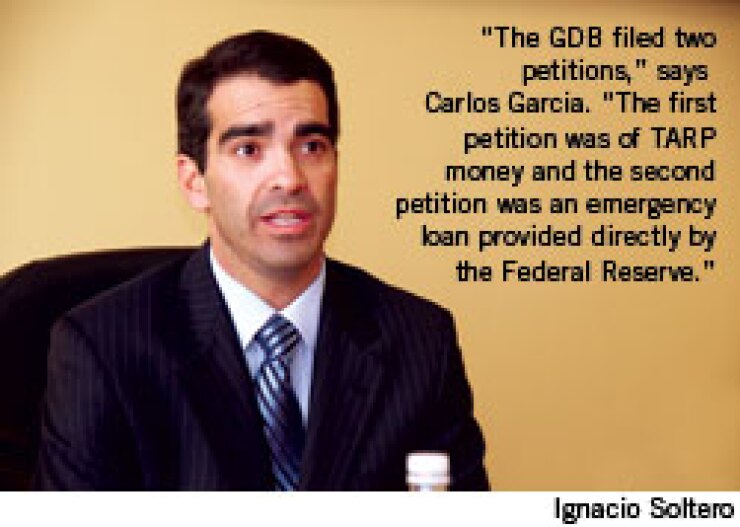
The Government Development Bank for Puerto Rico is seeking a $3 to $5 billion loan from the Federal Reserve and a potential $5 billion advance from the Troubled Asset Relief Program.
A financial boost from the federal government will help the GDB with its plans to jump-start Puerto Rico’s struggling economy through infrastructure investments and loans that it will extend to businesses. The island is in a protracted recession, has an unemployment rate of 13%, and will cut government payroll by 30,000 employees in the next year in order to reduce expenditures by $2 billion annually.
The federal loans would come on top of $5 billion the island will receive in federal stimulus funds through the American Recovery and Reinvestment Act of 2009 and a $500 million local stimulus plan that Puerto Rico lawmakers approved last week.
“Given the magnitude of the challenge, we have been working together in the government to work for an additional supplemental stimulus plan that will provide for economic development investment,” GDB president Carlos Garcia said Thursday during a conference call with municipal bond investors. “As part of that, the GDB filed two petitions. The first petition was of TARP money and the second petition was an emergency loan provided directly by the Federal Reserve. We continue to make strides and are working to secure the possibility of obtaining those funds. . . so far, the Federal Reserve has already received our application and is in the process of requesting additional information from us, which we’ll be providing by the end of this week or beginning of next week.”
After the conference call, Fernando Batlle, GDB’s executive vice president for financing and treasury said the bank requested $3 to $5 billion from the Fed and another $5 billion of TARP money. The bank has $2.5 billion of cash-on-hand and has an investment portfolio of roughly $5 billion.
“We’re working on a series of questions that they asked from us and they typically don’t do an unsecured lending so the function of how much it would be would be a function of the type of collateral we can give them,” Batlle told The Bond Buyer. “And we’re undergoing that analysis, but it will be a few billion dollars, between $3 and $5 billion dollars.”
In addition, the commonwealth plans in fiscal 2010 to issue $2.5 billion of sales-tax revenue bonds through the Puerto Rico Sales Tax Financing Corp. to help close a $3.2 billion deficit and finance new programs to help government workers find new employment, among other initiatives.
The GDB has yet to announce an underwriting team for the sales-tax transaction but are reviewing four final proposals, Batlle said. Officials will issue the first offering in April, a deal size of $250 million to $500 million, but could increase that amount, depending upon market conditions.
During the conference call, Garcia said the commonwealth is expected to bring in $7.4 billion of revenue in fiscal 2010, and if that amount fails to increase by fiscal 2012, Puerto Rico may look towards nearly $500 million of deficit financing again that year.
“A significant amount of fiscal deficit financing will be required in fiscal 2010, roughly $2.5 billion in order to compensate both for the stabilization of the budget deficit and also to be able to pay for the estimated $1 billion which is the cost estimate of the transition of the employees,” Garcia said during the conference call. “If we assume that the revenue base of the commonwealth stays at $7.4 billion, we may need an additional $500 million — or to be specific $493 million — in fiscal year 2012 in order to stabilize the financing.”
Lawmakers last week approved increasing the fund's sales-tax receipt allocation. The sales-tax fund will gain an additional three-quarters of a cent from the island’s seven-cent sales tax, bringing the total dedication to 2.75 cents. The .75 cent boost will allow the commonwealth to issue up to $7 billion of sales-tax bonds over the next few years, according to Batlle.
“As we stand today with this additional .75, the deal sizing is estimated to be approximately $7 billion over time,” Batlle said during the conference call. “As we’ve highlighted in the past, part of these funds will be used to repay debt that is sitting right now on GDB’s balance sheet and the balance will be used to fund certain programs such as the economic stimulus program and the deficit financing which will be part of the stabilization program.”
The commonwealth already has $5.2 billion of debt backed by 1% of sales-tax revenues. Puerto Rico’s sales-tax bonds are called COFINA bonds under its Spanish acronym. Officials refer to the existing $5.2 billion of sales-tax debt as COFINA-one bonds.
Garcia and his team are still ironing out details of the upcoming sale and looking to safeguard investors of the existing sales-tax bonds.
“As part of that process we’re still evaluating the different structuring alternatives, keeping in mind the importance of protecting existing COFINA-one bond holders,” Batlle said.
Fitch Ratings and Standard & Poor’s rate the COFINA bonds A-plus. Moody’s Investors Service rates the credit A1.
In addition, Moody’s released a report Thursday regarding the commonwealth’s recent passage of fiscal legislation and the plans to address the $3.4 billion deficit, in part, with deficit financing. Moody’s and Standard & Poor’s rate Puerto Rico Baa3 and BBB-minus, respectively, both with a stable outlook.
“As the laws go into effect and the stimulus proceeds are spent, we will be focused on the results they produce,” according to the Moody’s report. “In particular, we will be assessing the commonwealth’s liquidity situation; the maintenance of spending restraint; revenue performance; and the movement toward structural balance. In the meantime, until tangible results of these actions affect financial results and economic activity, our rating for the commonwealth’s general obligations remains Baa3 with a stable outlook.”





